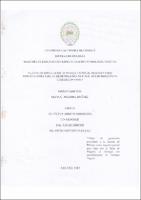Lluvia de semillas en un pasaje tropical fragmentado: implicaciones para la regeneración natural de los bosques en Chiriquí, Panamá.
Resumen
In the western region of Chiriquí, forest have been heavily deforested and fragmented resulting in a heterogeneous landscape. In these landscapes, spieces are facing changes in the spatial structure of the habitat, such as the loss of this, incresed isolation and creating borders, processes thata together can alter seed dispersal. This ecological relationship is key to the maintenance of biodiversity, so understanding this process response to changes in the landscape is essential to develop conservation and management strategies that promote forest regenaration in thes landscapes. In this paper we analyze how varies the composition and structure of the seed rain in fragmented landscape district Baru Chiriquí, Panamá, Inside the forest, edge forest - grassland, pasture and live fence: four elements of landscape increasingly common in framented tropical regions were evaluated. In each richness and abundace of seeds was evaluated for a year. The seeds were clasified based on their size and mode dispercion(Dispersed by biotic or abiotic means). Farhtermore, the composition of the adult trees nearby (diameter at breast heighty, DBH les than 10cm) was sampled to clasiffy spices based on their potential sources.
Community of fugivorous vertebrates in each of these elements to assess seed rain could be associated faunal diversity at each site was also sampled. 2019 species of fruit-eating animals inside the forest, five on the edge, four in the living fence and only two species were observed in the pasture. Seed rain in total of 942 seeds wwere recorder belonging to 29 species of 18 families. Most seeds (74%) were dispersed by abiotic means, and about half were small sedds. The interior of the fores recevied more seeds and more species than other landscape elemens. The pasture was the poorest site, with only two species of small seeds, dispersed by wind. the interior of the forest and were living near a greater abundance and species richness of immigrans. the spiecies, being the most dissimilar grassland site (J=0.07). The evaness of the community seed was higher in the forest interior and less on the edge. Together, these results indicate that seed dispersal appears interrupted in the pasture. However, living fences and the edges of the fragment were showererd with abundant and diverse seeds, so the can serve in management plans to promote forest regeneration in this region. However, the low abundance and diversity of spices dispersed by animals suggest that for this particular group of plans will be necesary to implement regeneration programs focused on these species.
Colecciones
- Maestría en Biología [33]

